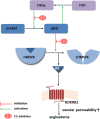Mast cell degranulation and bradykinin-induced angioedema - searching for the missing link
- PMID: 38812508
- PMCID: PMC11133555
- DOI: 10.3389/fimmu.2024.1399459
Mast cell degranulation and bradykinin-induced angioedema - searching for the missing link
Abstract
Initiation of the bradykinin generation cascade is responsible for the occurrence of attacks in some types of angioedema without wheals. Hereditary angioedema due to C1 inhibitor deficiency (HAE-C1-INH) is one such clinical entity. In this paper, we explore the existing evidence that mast cells (MCs) degranulation may contribute to the activation of the kallikrein-kinin system cascade, followed by bradykinin formation and angioedema. We present the multidirectional effects of MC-derived heparin and other polyanions on the major components of the kinin-kallikrein system, particularly on the factor XII activation. Although, bradykinin- and histamine-mediated symptoms are distinct clinical phenomena, they share some common features, such as some similar triggers and a predilection to occur at sites where mast cells reside, namely the skin and mucous membranes. In addition, recent observations indicate a high incidence of hypersensitivity reactions associated with MC degranulation in the HAE-C1-INH patient population. However, not all of these can be explained by IgE-dependent mechanisms. Mast cell-related G protein-coupled receptor-X2 (MRGPRX2), which has recently attracted scientific interest, may be involved in the activation of MCs through a different pathway. Therefore, we reviewed MRGPRX2 ligands that HAE-C1-INH patients may be exposed to in their daily lives and that may affect MCs degranulation. We also discussed the known inter- and intra-individual variability in the course of HAE-C1-INH in relation to factors responsible for possible variability in the strength of the response to MRGPRX2 receptor stimulation. The above issues raise several questions for future research. It is not known to what extent a prophylactic or therapeutic intervention targeting the pathways of one mechanism (mast cell degranulation) may affect the other (bradykinin production), or whether the number of mast cells at a specific body site and their reactivity to triggers such as pressure, allergens or MRGPRX2 agonists may influence the occurrence of HAE-C1-INH attacks at that site.
Keywords: C1 inhibitor deficiency; HAE; MRGPRX2; bradykinin; hereditary angioedema; mast cell.
Copyright © 2024 Porebski, Dziadowiec, Rybka, Kitel and Kwitniewski.
Conflict of interest statement
The authors declare that the research was conducted in the absence of any commercial or financial relationships that could be construed as a potential conflict of interest. The handling editor MR declared a past co-authorship with the author GP.
Figures


Similar articles
-
Pathogenic mechanisms of bradykinin mediated diseases: dysregulation of an innate inflammatory pathway.Adv Immunol. 2014;121:41-89. doi: 10.1016/B978-0-12-800100-4.00002-7. Adv Immunol. 2014. PMID: 24388213 Review.
-
Hypersensitivity reactions amongst Hungarian Patients with Hereditary Angioedema due to C1-Inhibitor Deficiency.World Allergy Organ J. 2023 Oct 23;16(11):100833. doi: 10.1016/j.waojou.2023.100833. eCollection 2023 Nov. World Allergy Organ J. 2023. PMID: 37920275 Free PMC article.
-
Angiogenic Host Defense Peptide AG-30/5C and Bradykinin B2 Receptor Antagonist Icatibant Are G Protein Biased Agonists for MRGPRX2 in Mast Cells.J Immunol. 2019 Feb 15;202(4):1229-1238. doi: 10.4049/jimmunol.1801227. Epub 2019 Jan 16. J Immunol. 2019. PMID: 30651343 Free PMC article.
-
Hereditary angioedema: Pathophysiology (HAE type I, HAE type II, and HAE nC1-INH).Allergy Asthma Proc. 2020 Nov 1;41(Suppl 1):S14-S17. doi: 10.2500/aap.2020.41.200081. Allergy Asthma Proc. 2020. PMID: 33109319 Review.
-
Human Mast Cell Line HMC1 Expresses Functional Mas-Related G-Protein Coupled Receptor 2.Front Immunol. 2021 Mar 15;12:625284. doi: 10.3389/fimmu.2021.625284. eCollection 2021. Front Immunol. 2021. PMID: 33790895 Free PMC article.
Cited by
-
Activation of the Complement/Lectin Pathway, Angiopoietin/Tie-2/VEGF-System, Cytokines and Chemokines in Different Angioedema Subtypes.Eur J Immunol. 2025 Jul;55(7):e70010. doi: 10.1002/eji.70010. Eur J Immunol. 2025. PMID: 40685762 Free PMC article.
-
Mast cells: key players in digestive system tumors and their interactions with immune cells.Cell Death Discov. 2025 Jan 15;11(1):8. doi: 10.1038/s41420-024-02258-y. Cell Death Discov. 2025. PMID: 39814702 Free PMC article. Review.
References
Publication types
MeSH terms
Substances
LinkOut - more resources
Full Text Sources

